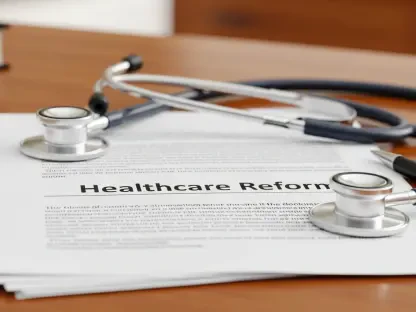Introduction to Nigeria’s Healthcare Challenges
In Nigeria, a nation of over 200 million people, the healthcare system grapples with an overwhelming demand that often outstrips available resources, leaving millions with limited access to quality medical services. University teaching hospitals, intended as pillars of advanced care and medical education, are frequently hampered by outdated infrastructure and uneven distribution across regions. This stark reality underscores the urgent need for systemic reform to bridge the gap between population growth and healthcare capacity. The Nigerian Senate’s recent move to advance a pivotal piece of legislation offers a glimmer of hope in addressing these longstanding issues, setting the stage for a transformative shift in how these critical institutions operate and serve the public.
The focus of this legislative effort is a bill aimed at amending the framework governing university teaching hospitals, a move that could redefine healthcare delivery and education in the country. By tackling both structural and managerial challenges, the Senate aims to modernize these facilities to meet contemporary needs. This report delves into the current state of Nigeria’s healthcare sector, the specifics of the proposed reforms, and the potential implications for the future of medical services and training.
Current State of Nigeria’s Healthcare and Teaching Hospitals Sector
Nigeria’s healthcare system faces significant hurdles, including inadequate funding, a shortage of skilled personnel, and infrastructure that struggles to keep pace with a rapidly growing population. University teaching hospitals, which are central to providing specialized care and training the next generation of healthcare professionals, often bear the brunt of these challenges. Many of these institutions operate with outdated equipment and facilities, limiting their ability to deliver optimal patient care or conduct cutting-edge research.
Beyond infrastructure deficits, the uneven distribution of teaching hospitals exacerbates regional disparities in healthcare access. While urban centers may have multiple facilities, rural areas are frequently underserved, leaving large swaths of the population without adequate medical services. This imbalance not only affects patient outcomes but also restricts opportunities for medical education in less developed regions.
The Senate’s introduction of the University Teaching Hospitals (Reconstitution of Boards, etc.) Act (Amendment) Bill, known as SB. 908, marks a critical response to these systemic issues. Sponsored by Senator Abba Patrick Moro of Benue South, this legislation seeks to update the 1985 Act, adapting it to address modern challenges and improve the functionality of teaching hospitals nationwide.
Legislative Details of the Teaching Hospitals Reform Bill
Key Provisions and Objectives of SB. 908
The primary objective of SB. 908 is to modernize the governance and operational framework of university teaching hospitals by amending outdated provisions from the original 1985 legislation. One of the key aspects of the bill involves updating the legal schedule to potentially include newly established or upgraded federal teaching hospitals. This expansion aims to ensure that more regions gain access to advanced medical facilities, thereby reducing the burden on existing institutions.
Another significant provision focuses on restructuring hospital management. The bill proposes broadening eligibility for leadership roles, such as Chief Medical Director, to include a wider range of healthcare professionals beyond just physicians. This shift is intended to bring diverse expertise into hospital administration, fostering a more collaborative and inclusive environment for decision-making.
The overarching goal of these amendments is to align the operations of teaching hospitals with current healthcare demands. By addressing both infrastructure and governance, the legislation seeks to create a more resilient system capable of meeting the needs of Nigeria’s expanding population over the coming years, from 2025 onward.
Anticipated Impact on Healthcare Delivery and Education
If enacted, SB. 908 could significantly enhance access to quality medical services by ensuring that teaching hospitals are better distributed across Nigeria’s diverse regions. This would mean shorter travel distances for patients in remote areas and a reduction in overcrowding at urban facilities. Improved access is expected to translate into better health outcomes for communities previously underserved by the healthcare system.
On the educational front, the inclusion of new teaching hospitals could expand training opportunities for aspiring healthcare professionals. More facilities would provide diverse clinical environments for hands-on learning, potentially increasing the number of skilled graduates entering the workforce. This is particularly crucial as Nigeria faces a persistent shortage of doctors, nurses, and other medical personnel.
Furthermore, the bill’s emphasis on inclusive leadership may encourage innovation within hospital settings. By integrating varied professional perspectives, teaching hospitals could become hubs for research and development, addressing local health challenges with tailored solutions. Over time, these reforms could position Nigeria’s healthcare system as more adaptive and responsive to both national and global demands.
Challenges in Reforming Teaching Hospitals Governance
Implementing the proposed reforms under SB. 908 is not without obstacles, particularly when it comes to altering long-standing governance structures. Resistance to change is likely, as traditional hierarchies in teaching hospitals have historically favored physician-led administration. Shifting toward a more inclusive model may face pushback from stakeholders accustomed to established norms, potentially slowing the adoption of new management practices.
Another concern lies in the risk of compromising leadership quality if eligibility criteria for key positions are not carefully defined. While broadening access to roles like Chief Medical Director is a progressive step, there must be stringent standards to ensure that only highly qualified individuals assume these responsibilities. Without such safeguards, there is a chance that hospital administration could suffer from a lack of expertise or experience.
Effective implementation will also require robust stakeholder engagement and capacity building. Training programs and consultations with healthcare professionals across disciplines will be essential to prepare for the transition to new governance models. Addressing these challenges head-on will be critical to realizing the full potential of the proposed legislative changes without disrupting the functionality of teaching hospitals.
Regulatory and Policy Implications of the Bill
The introduction of SB. 908 must be viewed within the broader context of healthcare governance in Nigeria, where regulatory frameworks often struggle to keep pace with evolving needs. This bill represents an opportunity to harmonize policies governing teaching hospitals with national health objectives, ensuring that these institutions operate under clear and consistent guidelines. Such alignment is vital for maintaining accountability and efficiency in hospital operations.
A key policy consideration is the establishment of precise qualifications for leadership roles to uphold high standards in administration. The bill must balance inclusivity with competence, ensuring that diverse professionals are given opportunities while maintaining rigorous benchmarks for skills and experience. This dual focus will help prevent any decline in the quality of hospital management during the reform process.
Compliance and oversight will also play a pivotal role in the success of these reforms. Mechanisms must be put in place to monitor the implementation of the bill’s provisions and address any deviations from intended outcomes. Strong regulatory oversight will ensure that the objectives of expanding infrastructure and diversifying leadership translate into tangible improvements in healthcare delivery and education.
Future Outlook for Nigeria’s Teaching Hospitals
Looking ahead, the reforms proposed in SB. 908 hold the potential to fundamentally modernize Nigeria’s healthcare system by addressing both structural and operational shortcomings. The expansion of teaching hospital infrastructure could lay the groundwork for a more equitable distribution of medical resources, ensuring that even remote areas benefit from advanced care and training facilities. This long-term vision aligns with the country’s broader goal of improving health indices.
Inclusivity in leadership, if executed effectively, could transform teaching hospitals into centers of innovation and collaboration. By leveraging the expertise of various healthcare professionals, these institutions might pioneer new approaches to patient care and medical research, positioning Nigeria as a leader in addressing regional health challenges. This shift could also attract international partnerships and funding, further bolstering the sector.
However, external factors such as economic conditions and global healthcare trends will inevitably influence the outcomes of these reforms. Fluctuations in government funding, coupled with worldwide shifts toward digital health and telemedicine, may require teaching hospitals to adapt beyond the scope of current legislation. Navigating these dynamics will be essential to sustaining the momentum of reform and ensuring that Nigeria’s healthcare system remains competitive on a global scale.
Closing Reflections and Next Steps
Reflecting on the discussions surrounding SB. 908, it is clear that the Nigerian Senate has taken a bold step in addressing systemic challenges within the healthcare sector through this legislative initiative. The dual emphasis on expanding infrastructure and reforming governance captures a comprehensive approach to modernizing university teaching hospitals. This effort highlights a commitment to equity and innovation in medical service delivery and education.
Moving forward, actionable steps are necessary to ensure the successful rollout of these reforms. Establishing clear, rigorous standards for leadership roles emerges as a priority to safeguard the quality of hospital administration. Additionally, sustained investment in training and stakeholder collaboration is crucial for overcoming resistance and building capacity for change.
Lastly, continuous evaluation and adaptation of the reforms are recommended to address unforeseen challenges and align with evolving global healthcare trends. Setting up robust monitoring systems to track progress and impact will provide valuable insights for refining policies over time. These considerations offer a roadmap for transforming the vision of SB. 908 into lasting improvements for Nigeria’s healthcare landscape.









